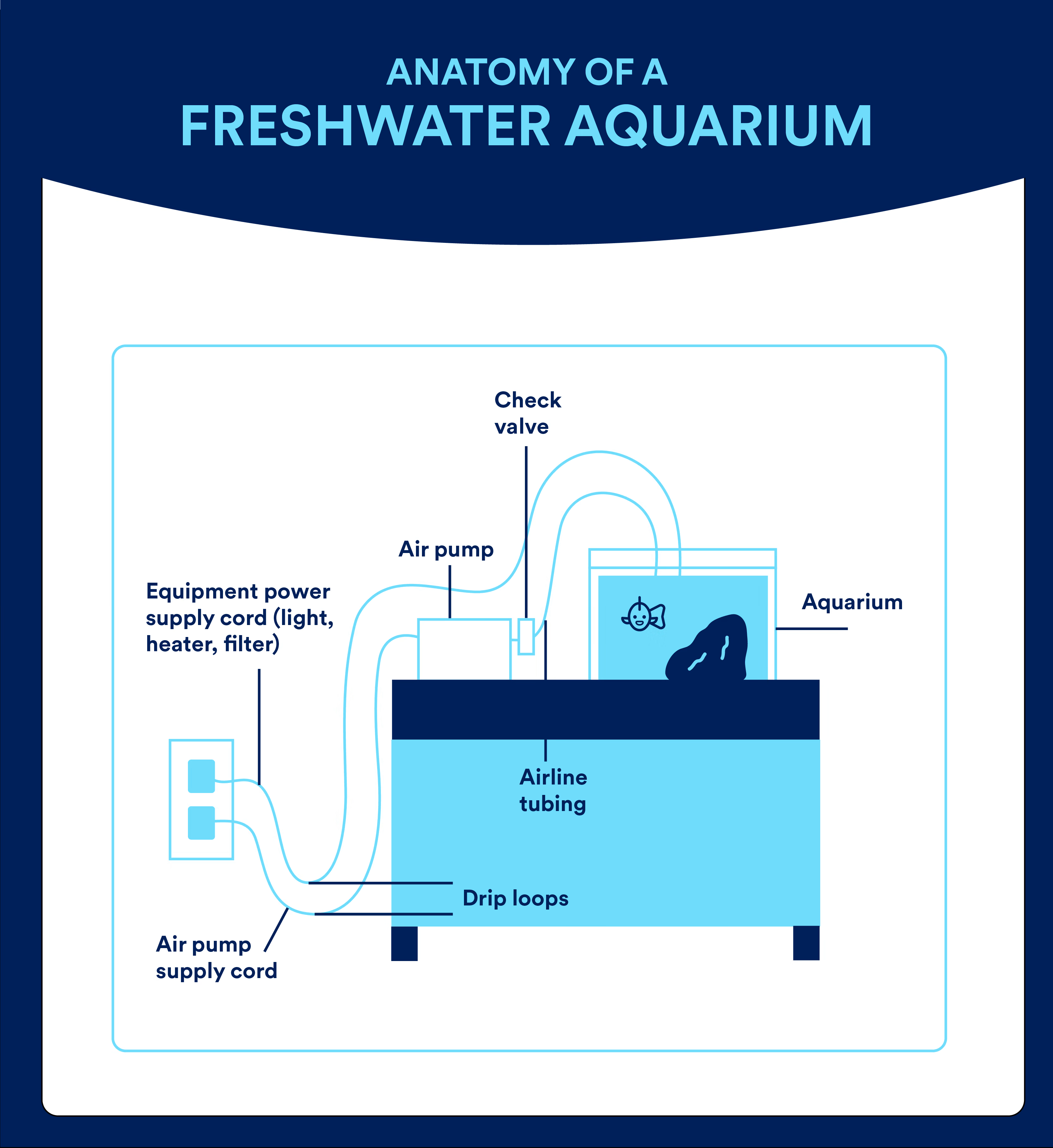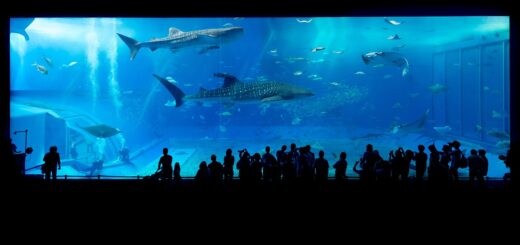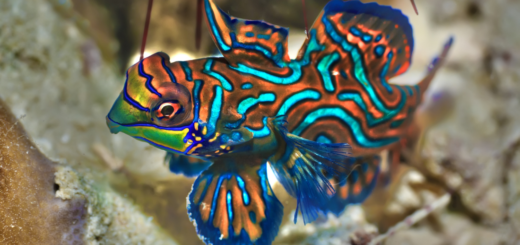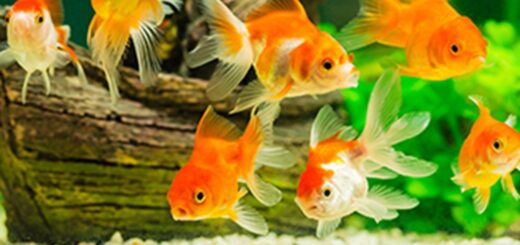The Aquarium Setup Guide: Creating The Ideal Habitat For Your Fish
Are you thinking about bringing the beauty and tranquility of an aquarium into your home? Look no further than “The Aquarium Setup Guide: Creating the Ideal Habitat for Your Fish.” In this comprehensive article, you’ll discover everything you need to know to set up the perfect environment for your fish to thrive. From choosing the right tank size to selecting the best filtration system, this guide will walk you through each step, ensuring that your fish have a safe and comfortable home. Say goodbye to guesswork and hello to a vibrant underwater world for you and your fish to enjoy together.
This image is property of assets.petco.com.
Click here…Your Spirit Animal is Trying to Connect…
Choosing the Right Aquarium
Determining the Appropriate Size
When it comes to choosing an aquarium, size plays a vital role in the overall well-being of your fish. It’s recommended to consider the adult size of the fish you plan to keep to ensure they have enough space to swim and thrive. As a general rule of thumb, it’s better to opt for a larger tank rather than a smaller one. This will provide a more stable environment and allow for better water quality. Take into account the available space in your home and choose the largest tank that fits comfortably within that area.
Selecting the Suitable Shape
Aquariums come in various shapes, each with its own unique benefits. The most common shapes include rectangular, square, bow-front, hexagonal, and cylindrical. Rectangular tanks are popular due to their versatility and ease of maintenance. Square tanks provide a larger viewing area, while bow-front tanks offer a curved front panel that enhances the viewing experience. Hexagonal and cylindrical tanks are visually appealing but may limit swimming space for some fish. Consider the aesthetic appeal as well as the practicality of the shape when making your decision.
Considering Glass or Acrylic Material
Choosing between glass and acrylic is an important decision when it comes to your aquarium. Glass is sturdy, scratch-resistant, and provides excellent clarity. It is more durable and less prone to discoloration over time. Acrylic, on the other hand, is lighter in weight and less likely to shatter. It allows for more unique shapes and offers better insulation, making it more energy-efficient. Consider your specific needs and preferences to determine which material is best for you.
Checking for Necessary Equipment
Before setting up your aquarium, it’s essential to ensure you have all the necessary equipment. This includes a filtration system to keep the water clean and clear of toxins, a heating system to maintain consistent water temperature, lighting to provide illumination for both the fish and plants, and a reliable thermometer to monitor water temperature. It’s also helpful to have a net for safely capturing and transferring fish, as well as a siphon or gravel vacuum for regular water changes. Make a checklist and ensure you have all the required equipment before proceeding with the setup.
Setting Up the Aquarium
Selecting the Right Location
Choosing the right location for your aquarium is crucial for the well-being of your fish. Avoid placing the tank in direct sunlight or near windows, as this can lead to excessive algae growth and temperature fluctuations. Instead, choose a spot away from direct sunlight and heat sources such as radiators. Ensure the surface where the aquarium will sit is level and stable, as an uneven surface can cause stress on the tank and potentially lead to leaks. It’s also important to consider accessibility for maintenance and viewing pleasure.
Preparing the Water
Before adding fish to your aquarium, it’s essential to prepare the water properly. Tap water contains chlorine and other chemicals that can be harmful to fish. To remove these substances, use a water conditioner specifically designed for aquarium use. Follow the instructions on the water conditioner to ensure the correct dosage based on the volume of water being treated. It’s also a good idea to use a water test kit to check the pH level and adjust if necessary. Allow the treated water to stand for a few hours to reach room temperature before adding it to the tank.
Adding Substrate and Decor
Adding substrate and decor not only enhances the aesthetic appeal of your aquarium but also provides hiding spots and territories for the fish. Choose a substrate that is appropriate for the type of fish you plan to keep. For example, sand is preferred for bottom-dwelling fish, while gravel is suitable for most freshwater species. Rinse the substrate thoroughly before adding it to the tank to remove any dust or debris. As for decor, consider natural-looking ornaments, rocks, driftwood, and live plants. Be mindful of the fish’s behavior and the compatibility of the decor with their specific needs.
Installing the Filtration System
A reliable filtration system is essential to maintain clean and healthy water in your aquarium. There are three main types of filtration: mechanical, chemical, and biological. Mechanical filtration removes debris and solid waste, chemical filtration removes harmful substances, and biological filtration supports the growth of beneficial bacteria. It’s recommended to choose a filter that can handle at least double the water volume of your tank. Follow the manufacturer’s instructions for proper installation and regular maintenance to ensure optimal performance.
Setting Up the Heating System
Maintaining a stable water temperature is crucial for the well-being of your fish. Most tropical fish require a water temperature between 75-82°F (24-28°C). In order to achieve and maintain this temperature, an aquarium heater is necessary. Choose a heater with a thermostat that allows for precise temperature control. Install the heater close to the filter outlet to ensure even heat distribution. It’s important to regularly monitor and adjust the heater as needed to maintain the desired temperature.
Providing Appropriate Lighting
Proper lighting is not only important for the aesthetics of your aquarium but also for the health of the fish and plants. Different types of fish and plants have specific lighting requirements, so consider their needs when selecting the appropriate lighting system. LED lights are energy-efficient and provide a wide range of customizable options. Fluorescent lights are suitable for most aquarium setups. Ensure the lighting is on for the appropriate duration, usually 8-12 hours a day, to simulate day and night cycles for the fish and promote plant growth.
This image is property of assets.petco.com.
Click here…Your Spirit Animal is Trying to Connect…
Aquarium Water Parameters
Understanding Water Temperature
Maintaining the appropriate water temperature is essential for the overall health and well-being of your fish. Different species have different temperature requirements, so it’s crucial to research the specific needs of the fish you plan to keep. Use a reliable thermometer to monitor the water temperature regularly and make adjustments as necessary. Sudden temperature fluctuations can cause stress or even death to your fish. Invest in a high-quality heater and ensure it is properly calibrated to maintain a stable water temperature within the recommended range.
Maintaining Proper pH Levels
The pH level of your aquarium is a measure of its acidity or alkalinity. Fish have specific pH preferences, and maintaining the appropriate pH level is crucial for their overall health and well-being. Research the preferred pH range for the fish species you plan to keep and regularly test the water using a pH test kit. If the pH level is too high or too low, there are commercially available pH adjusters that can help stabilize the water. Avoid drastic pH changes, as this can cause stress to your fish.
Checking Ammonia and Nitrite Levels
Ammonia and nitrite are toxic substances that can be harmful to fish if present in high concentrations. These substances are byproducts of fish waste and decaying organic matter in the aquarium. A build-up of ammonia or nitrite can be harmful or even fatal to fish. To avoid this, test the water regularly using an ammonia and nitrite test kit. If the levels are high, perform partial water changes to dilute the toxins and consider adding beneficial bacteria to help break down and convert ammonia and nitrite into less harmful nitrate.
Monitoring Nitrate Levels
While nitrate is a less toxic substance compared to ammonia and nitrite, high nitrate levels can still be detrimental to the health of your fish. Nitrate is produced by beneficial bacteria in the aquarium during the nitrogen cycle. Regular water changes and the presence of live plants can help keep nitrate levels under control. Test the water using a nitrate test kit and aim to keep the levels below 40 parts per million (ppm). If nitrate levels consistently rise above this threshold, consider increasing the frequency of water changes or adding more live plants to absorb excess nitrate.
Importance of Water Hardness
Water hardness refers to the amount of dissolved minerals, such as calcium and magnesium, in the water. Different fish species have different preferences for water hardness, so it’s important to research the specific requirements of the fish you plan to keep. Water hardness can be measured using a water test kit and is usually expressed in degrees of hardness (dH) or parts per million (ppm). If the water hardness is not within the preferred range, there are commercially available products that can help adjust the hardness level.
Maintaining Oxygen Levels
Fish require oxygen to survive, and maintaining adequate oxygen levels in your aquarium is crucial. Oxygen enters the water through various means, including surface agitation, air stones, and live plants. Ensure proper water circulation and surface agitation to facilitate the exchange of gases. Live plants play a significant role in oxygen production through photosynthesis. Consider adding live plants to your aquarium to help maintain oxygen levels and create a more natural and balanced environment for your fish.
Choosing the Right Fish
Researching Fish Species
When selecting fish for your aquarium, it’s important to thoroughly research the species you are interested in keeping. Consider factors such as adult size, preferred water parameters, compatibility with other fish, and dietary needs. Some fish require specific tank conditions, while others may be more adaptable. Take into account the level of care and maintenance required for each species and choose fish that are suitable for your level of experience and commitment. Remember, each fish is unique, and providing the best possible habitat for them is crucial for their health and well-being.
Understanding Compatibility
Fish compatibility refers to the ability of different species to coexist in the same aquarium without causing harm or stress to each other. Some fish are more aggressive and territorial, while others are peaceful and social. Research the temperament and behavior of the fish species you plan to keep to ensure they are compatible with each other. Avoid keeping fish that are known to be aggressive or have conflicting territorial behaviors. It’s crucial to provide each fish with ample space and hiding spots to establish their own territories and minimize stress.
Considering Fish Size and Number
Taking into account the adult size of the fish you plan to keep is essential to ensure they have enough space to swim and thrive. Overcrowding can lead to stress, poor water quality, and increased aggression among the fish. Consider the recommended minimum tank size for each species and calculate how many fish can be comfortably accommodated. It’s better to keep fewer fish in a properly sized tank than to overcrowd it. Monitor the growth of your fish and be prepared to rehome them or upgrade to a larger tank if needed.
Adapting to Specific Water Conditions
Different fish species have specific water parameter requirements, including temperature, pH level, hardness, and salinity. It’s important to choose fish that can adapt to the current water conditions of your aquarium or be willing to make the necessary adjustments to meet their needs. Trying to maintain an environment that doesn’t match the natural habitat of the fish can be stressful and potentially harmful to their health. Research the preferred water parameters for the fish species you plan to keep and ensure you can provide a suitable environment.
Introducing Fish Gradually
When introducing new fish to your aquarium, it’s crucial to do so gradually to minimize stress and allow for proper acclimation. Before adding fish, ensure the water parameters are stable and within the desired range. Float the sealed bag containing the fish in the aquarium for about 15-20 minutes to allow for temperature equalization. Open the bag and add small amounts of aquarium water to it every few minutes, gradually increasing the volume. After approximately 30 minutes, gently release the fish from the bag into the aquarium. Monitor their behavior closely during the acclimation process.
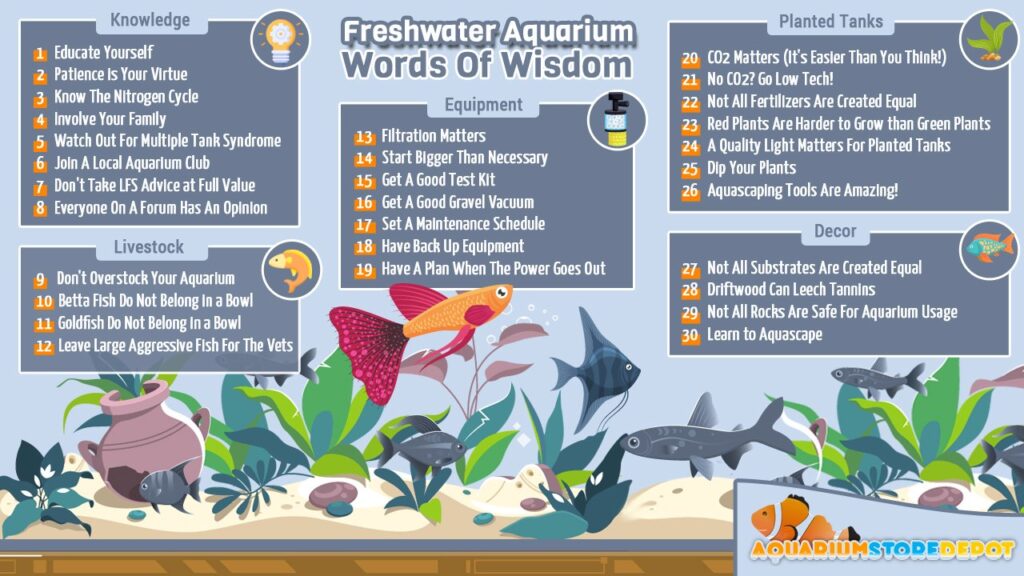
This image is property of aquariumstoredepot.com.
Feeding and Nutrition
Determining the Dietary Needs
Proper nutrition is vital for the health and well-being of your fish. Different fish species have varying dietary requirements, including the type of food, feeding frequency, and portion size. Research the specific dietary needs of the fish you plan to keep and choose a high-quality fish food that provides the necessary nutrients. Some fish are herbivores and require a diet rich in plant matter, while others are carnivores or omnivores and need a diet that includes both animal and plant-based foods. It’s important to provide a varied and balanced diet for optimal health.
Choosing the Right Fish Food
When it comes to selecting fish food, there are various options available, including flakes, pellets, frozen food, and live food. Flakes and pellets are the most common and convenient choices, providing a balanced diet for most fish species. However, some fish may require additional supplementation with frozen or live food to meet their specific dietary needs. Consider the size of the fish and their feeding habits when choosing the appropriate food. It’s important to feed your fish a variety of foods to ensure they receive all the necessary nutrients for optimal health and growth.
Establishing a Regular Feeding Schedule
Establishing a consistent feeding schedule is crucial for the overall health and well-being of your fish. Most fish should be fed small amounts multiple times a day, while others may require only one or two feedings per day. Avoid overfeeding, as it can lead to poor water quality and health issues for your fish. Monitor the feeding habits of your fish and adjust the portion size and frequency accordingly. It’s also a good practice to feed your fish at the same time every day to help establish a routine and minimize stress.
Avoiding Overfeeding
Overfeeding is a common mistake made by many aquarium owners and can have detrimental effects on the health of your fish and the overall water quality of your aquarium. Overfeeding leads to excess waste and uneaten food, which can cause water pollution and lead to harmful ammonia and nitrite spikes. Feed your fish small portions that they can consume within a few minutes. If there is uneaten food after feeding, remove it from the tank promptly. Remember, it’s better to slightly underfeed your fish than to overfeed them.
Supplementing with Live or Frozen Food
To provide additional nutritional benefits and variety to your fish’s diet, consider supplementing their meals with live or frozen food. Many fish species thrive on foods such as brine shrimp, bloodworms, daphnia, and tubifex worms. These live or frozen foods are rich in essential nutrients and can simulate the natural diet of fish in the wild. However, it’s important to ensure the live or frozen food is appropriate for your fish’s dietary needs and does not introduce any harmful parasites or diseases. Feed live or frozen food sparingly, as it should not replace the staple diet provided by commercial fish food.
Aquarium Maintenance
Performing Regular Water Changes
Regular water changes are essential for maintaining clean, healthy water conditions in your aquarium. Water changes help remove accumulated toxins, waste, excess nutrients, and maintain proper water parameters. As a general guideline, a 25% to 30% water change should be performed every two to four weeks. However, the frequency and volume of water changes may vary depending on the size of your tank, the number of fish, and the quality of your water. Use a siphon or gravel vacuum to remove debris from the substrate during water changes.
Cleaning the Tank and Decor
In addition to regular water changes, it’s important to clean the tank and decor to prevent the build-up of algae, waste, and other debris. Use a dedicated aquarium scraper or sponge to clean the glass or acrylic walls of the tank, removing any algae or mineral deposits. Gently scrub the decor, rocks, and driftwood to remove any accumulated debris. Avoid using chemicals or soaps, as they can be harmful to fish. Rinse everything thoroughly with dechlorinated water before returning them to the tank.
Maintaining the Filtration System
The filtration system is the heart of your aquarium, responsible for maintaining water quality by removing waste and harmful substances. Regular maintenance of the filtration system is essential to ensure it functions optimally. Follow the manufacturer’s instructions for cleaning and replacing the filter media, typically every four to six weeks. It’s important not to replace all the filter media at once, as it houses beneficial bacteria essential for biological filtration. Rinse the filter media in dechlorinated water to remove debris, but avoid using tap water or chlorinated water, as it can kill beneficial bacteria.
Testing Water Parameters
Regularly testing water parameters is an important part of aquarium maintenance to ensure optimal water quality for your fish. Use a reliable water test kit to monitor ammonia, nitrite, nitrate, pH, and other relevant parameters. Test the water weekly or as recommended by the test kit instructions. Keeping track of the water parameters will help identify any imbalances or potential issues before they become harmful to your fish. Adjust water conditions as necessary through proper water changes or the use of water conditioners and other water treatment products.
Removing Excess Algae
Algae growth is a common occurrence in aquariums and can affect the overall aesthetics and water quality. To control excess algae growth, maintain a proper balance of light, nutrients, and carbon dioxide in the aquarium. Regularly clean the glass or acrylic walls of the tank using an algae scraper or sponge. Reduce the duration of light exposure or adjust the lighting intensity if algae growth becomes excessive. Adding algae-eating fish or shrimp, such as plecos or amano shrimp, can also help control algae growth naturally. Avoid the use of algaecides or other chemicals, as they can harm your fish and disrupt the balance of your aquarium.
Preventing and Treating Common Diseases
Like any pets, fish are susceptible to diseases and infections. Prevention is key to maintaining a healthy aquarium. Ensure optimal water quality, proper nutrition, and a stress-free environment for your fish. Quarantine new fish before introducing them to the main tank to prevent the spread of diseases. Monitor your fish closely for any signs of distress, changes in behavior, or physical abnormalities. If you suspect a disease, promptly isolate the affected fish and seek advice from a knowledgeable aquarium professional or veterinarian with experience in fish health. Follow their recommendations for treatment and prevention strategies.
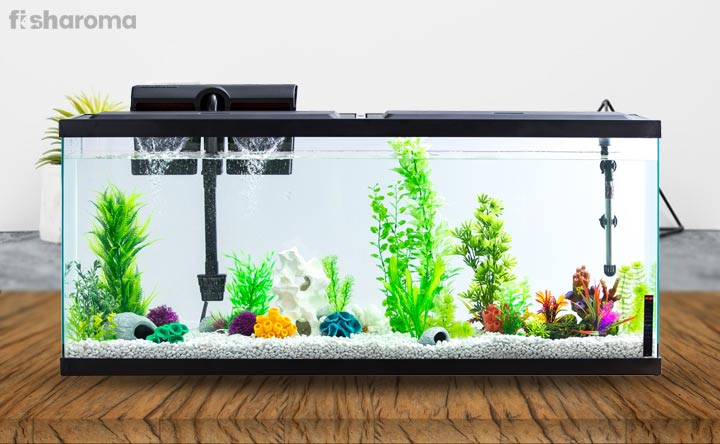
This image is property of fisharoma.com.
Aquarium Safety
Ensuring Electrical Safety
Safety should always be a top priority when setting up and maintaining an aquarium. Avoid placing electrical equipment near water to prevent the risk of electric shock or short circuits. Use waterproof cables and sockets specifically designed for aquarium use. Securely fasten and conceal cables to prevent fish from becoming entangled or chewing on them. Regularly inspect electrical equipment for signs of wear or damage. In case of a power outage or electrical failure, ensure you have a backup power source or a battery-powered air pump to provide temporary aeration for your fish.
Selecting Non-Toxic Materials
Using non-toxic materials is crucial to the health and safety of your fish. Choose aquarium-safe decor, substrate, and equipment that do not leach harmful chemicals into the water. Avoid using painted objects, metals, or materials that may rust or deteriorate over time. Research and purchase products from reputable aquarium manufacturers to ensure their safety and compatibility with aquatic life. If you are unsure about the suitability of a specific material, consult with a knowledgeable aquarium professional or do thorough research before introducing it to your tank.
Avoiding Overcrowding
Overcrowding can have detrimental effects on the health and well-being of your fish. It can lead to stress, poor water quality, and increased aggression among the fish. Follow the recommended stocking guidelines for your specific fish species and tank size. Consider the adult size and territorial behaviors of the fish you plan to keep. A well-planned and properly sized aquarium will provide ample swimming space and territories for each fish, minimizing stress and promoting a harmonious environment.
Preventing Fish Escapes
Fish can be surprisingly adept at finding their way out of an aquarium, so it’s important to take necessary precautions to prevent any escapes. Ensure the aquarium has a secure lid or cover to prevent fish from jumping out. Use a lid that allows for proper ventilation and any necessary equipment, such as a heater or filter, to fit securely. Regularly inspect the lid for any damage or gaps that may compromise its effectiveness. If you notice any fish attempting to jump, consider adding additional barriers or adjusting the tank environment to reduce stress and minimize the risk of escape.
Protecting Aquarium from Pets and Children
If you have pets or children in your household, it’s important to take precautions to prevent any accidents or harm to the aquarium and its inhabitants. Keep the aquarium out of reach of pets or install a sturdy barrier to prevent them from accessing the tank. Some pets may be curious or may view fish as potential prey. Educate children on the importance of not tapping on the glass, trying to catch fish, or putting foreign objects into the aquarium. Supervise interactions between pets, children, and the aquarium to ensure the safety and well-being of both.
Aquarium Aquascaping
Understanding the Basics of Aquascaping
Aquascaping is the art of designing and arranging plants, rocks, and other decor in your aquarium to create a visually appealing and natural-looking underwater environment. Aquascaping not only enhances the aesthetics of your tank but also provides hiding spots, territories, and natural behavior stimulation for your fish. Research different aquascaping styles, such as Dutch style, nature style, or biotope style, to find inspiration and guidance for your own design. Experiment with different layouts, heights, colors, and textures to create a unique and captivating aquatic landscape.
Choosing Suitable Plants
Live plants not only add beauty to your aquarium but also provide numerous benefits for your fish. They help oxygenate the water, remove excess nutrients, provide hiding spots, and simulate the natural habitat of the fish. When selecting plants, consider their lighting requirements, growth rate, preferred water parameters, and compatibility with your fish. Some popular aquarium plants include Java Fern, Anubias, Vallisneria, and Amazon Sword. Choose plants that are suitable for your tank size, lighting setup, and level of maintenance commitment.
Arranging Rocks and Driftwood
Rocks and driftwood can be used to create natural-looking structures, caves, and ledges in your aquarium. They provide hiding spots, territorial boundaries, and a sense of depth to the aquascape. When selecting rocks, choose aquarium-safe rocks that won’t alter the water chemistry or leach harmful substances. Before adding them to the aquarium, rinse the rocks thoroughly to remove any dust or debris. Consider the weight, size, and arrangement of the rocks to ensure they are stable and won’t collapse or harm the fish. Similarly, when using driftwood, select aquarium-safe driftwood that won’t release tannins or discolor the water.
Creating Focal Points
Focal points are key elements of an aquascape that draw the viewer’s attention and create visual interest. They can be created using plants, rocks, or wood. Consider the placement, size, and color contrast of these focal points to create a visually pleasing composition. Use taller plants or hardscape elements to create height and vertical interest. Consider the points of view from different angles to ensure the focal points are visible from various perspectives. Experiment with different arrangements and elements until you achieve a visually striking focal point that enhances the overall aesthetics of your aquarium.
Implementing the Right Color Scheme
Color plays a significant role in creating visually stunning aquascapes. Consider the color scheme you want to achieve and select plants, rocks, and decor that complement each other. Some aquarists prefer a vibrant and colorful palette, while others prefer a more natural and muted palette. Consider the colors of your fish and choose plants and hardscape elements that will enhance their natural colors. Experiment with contrasting or complementary colors to create visual harmony and balance. Regularly trim and maintain the plants to prevent them from overshadowing or overpowering the overall color scheme.
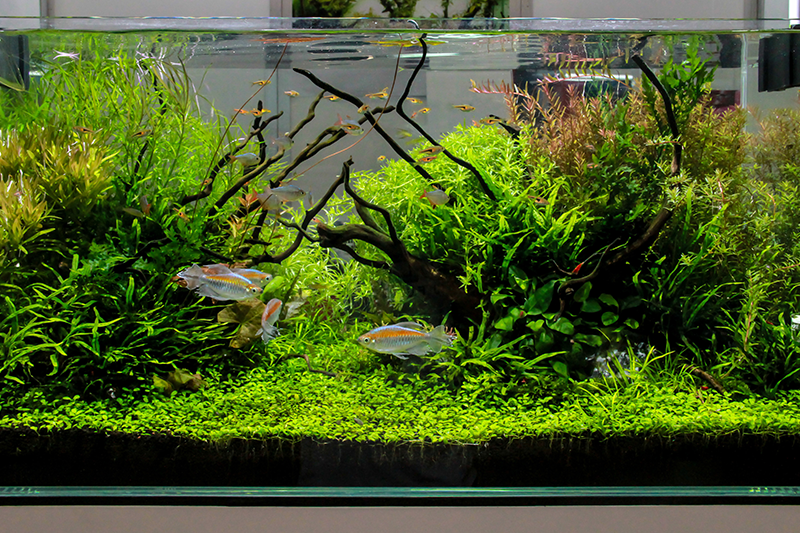
This image is property of www.petbarn.com.au.
Aquarium Fish Behavior
Observing Natural Behavior Patterns
Observing your fish’s natural behavior patterns is not only fascinating but also provides valuable insight into their well-being. Pay attention to how the fish swim, eat, interact with each other, and use the aquarium environment. Observe any changes in behavior, such as increased aggression, lethargy, or loss of appetite, as they may indicate potential health issues or environmental stressors. Understanding your fish’s normal behavior will help you identify any abnormalities and take prompt action if needed.
Understanding Territoriality
Many fish species exhibit territorial behavior, especially when placed in a confined space such as an aquarium. Territorial fish establish and defend their territories, which can lead to aggression and stress if not properly managed. Provide ample space, hiding spots, and boundaries for each fish to establish its own territory. If aggression becomes a problem, consider rearranging the decor or adding visual barriers to separate territories. In some cases, keeping only one or a few individuals of a territorial species may be necessary to maintain a harmonious environment.
Recognizing Signs of Stress
Fish can experience stress due to various reasons, including poor water quality, overcrowding, incompatible tankmates, or changes in the environment. Stress can have detrimental effects on their health and well-being, making it important to be able to recognize the signs. Common signs of stress in fish include loss of appetite, abnormal swimming behavior, clamped fins, increased hiding, or aggressive behavior. If you notice any of these signs, assess the potential causes and take appropriate actions, such as improving water quality, rehoming aggressive fish, or providing more suitable tank conditions.
Promoting Natural Behavior through Enrichment
Providing opportunities for natural behavior expression is vital for the overall health and well-being of your fish. Mimic their natural environment by offering hiding spots, plants, and decor that allow them to exhibit natural behaviors like exploring, foraging, or nesting. Use feeding enrichment techniques such as puzzle feeders or food-dispensing toys to promote mental stimulation and physical activity. Regularly change the layout or introduce new elements to simulate a dynamic environment. Creating an enriched environment helps combat boredom and stress, and encourages the natural instincts of your fish.
Maintaining a Harmonious Environment
A harmonious environment in your aquarium is crucial for the health and well-being of your fish. Proper stocking density, compatible tankmates, suitable territories, and a well-designed aquascape all contribute to a harmonious environment. Avoid overcrowding, aggressive species combinations, or environmental conditions that may lead to stress or territorial conflicts. Monitor the behavior and health of your fish regularly and make adjustments as necessary to ensure a peaceful and balanced aquarium community.
Aquarium Emergency Preparedness
Having a Backup Power Source
Power outages can be detrimental to the health and safety of your fish, especially if they rely on electrical equipment such as filters, heaters, and air pumps. Having a backup power source, such as a battery-operated air pump or a generator, is crucial to maintain adequate aeration and filtration during power outages. Ensure your backup power source is ready and accessible when needed. Regularly check and maintain the battery or generator to ensure they are in working condition.
Being Prepared for Power Outages
Power outages can cause rapid changes in water temperature and oxygen levels, which can be harmful or even fatal to your fish. In case of a power outage, it’s important to be prepared and have a plan in place. Keep a battery-operated thermometer in your aquarium to monitor the water temperature during power outages. Insulate the aquarium to help retain heat, such as covering it with a blanket or towels. Avoid feeding your fish during an outage to minimize waste buildup. When power is restored, perform a water test to assess any changes in water parameters and take appropriate action, such as water changes, to restore optimal conditions.
Managing Equipment Failures
Equipment failures can happen unexpectedly and disrupt the delicate balance of your aquarium. Regularly inspect and maintain your equipment, including filters, heaters, and lights, to ensure proper functioning. Have spare parts or replacement equipment readily available in case of emergencies. If an equipment failure occurs, take immediate action to address the issue. For example, if a filter stops working, perform partial water changes to maintain water quality while repairing or replacing the filter. Regularly monitor your equipment and promptly address any signs of malfunction or deterioration.
Having a Plan for Relocation
There may be situations where you need to relocate your aquarium temporarily or permanently. It’s important to have a plan in place to minimize stress and potential harm to your fish during the relocation process. When relocating, carefully and securely pack your fish in appropriate containers with enough water and oxygen for the duration of the journey. Maintain stable water temperature and provide a dark and quiet environment to reduce stress. Set up the new aquarium as soon as possible, ensuring proper water conditions and acclimation of the fish. Gradually introduce the fish to the new environment, closely monitoring their behavior and health during the transition.
Engaging Emergency Measures in Case of Fish Illness
Fish illnesses can occur, and it’s crucial to take immediate action to prevent the spread and treat the illness effectively. Quarantine any affected fish to prevent the spread of contagious diseases to the rest of the aquarium inhabitants. Research the symptoms and potential causes of the illness to determine the appropriate treatment. Follow the recommendations of a knowledgeable aquarium professional or veterinarian with experience in fish health. Administer medication or treatment as directed and monitor the fish closely for any signs of improvement or worsening. Address any underlying water quality or environmental issues that may have contributed to the illness to prevent future occurrences.


